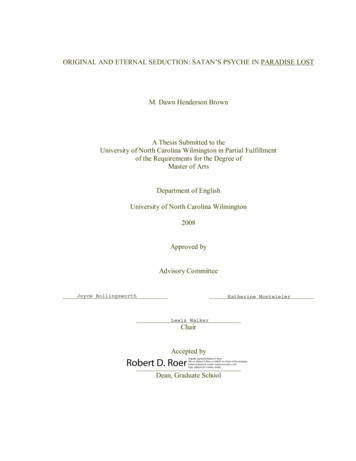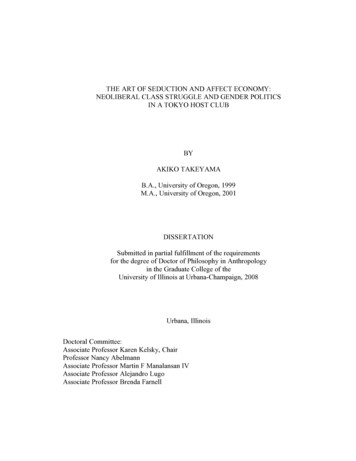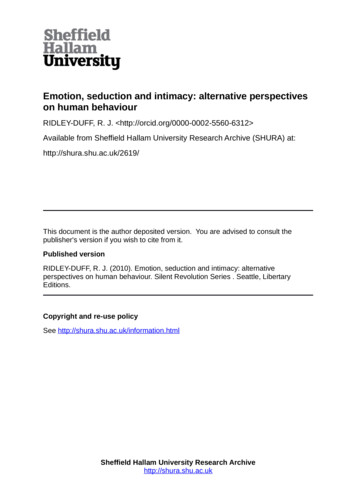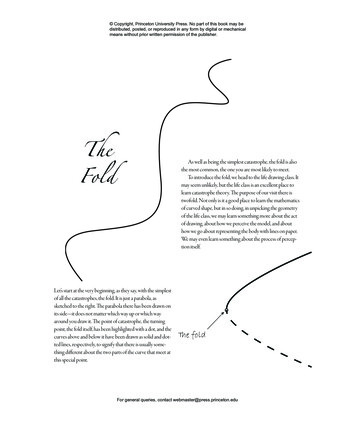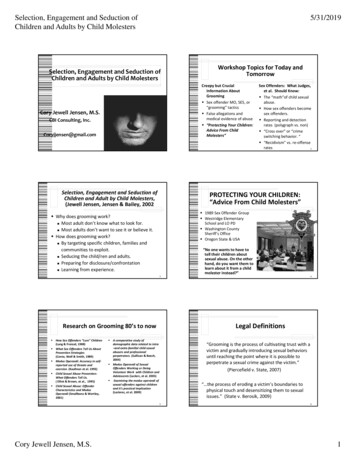
Transcription
Selection, Engagement and Seduction ofChildren and Adults by Child Molesters5/31/2019Selection, Engagement and Seduction ofChildren and Adults by Child MolestersWorkshop Topics for Today andTomorrowCreepy but CrucialInformation AboutGrooming Sex offender MO,MO SES,SES or“grooming” tactics False allegations andmedical evidence of abuse “Protecting Your Children:Advice From ChildMolesters”Cory Jewell Jensen, M.S.CBI Consulting, Inc.Coryjjensen@gmail.com1Selection, Engagement and Seduction ofChildren and Adult by Child Molesters,(Jewell Jensen, Jensen & Bailey, 2002Sex Offenders: What Judges,et al. Should Know: The “math”of child sexualabuseabuse. How sex offenders becomesex offenders. Reporting and detectionrates (polygraph vs. non) “Cross over” or “crimeswitching behavior. “ “Recidivism” vs. re‐offenserates2PROTECTING YOUR CHILDREN:“Advice From Child Molesters” 1989 Sex Offender Group Westridge ElementarySchool and LO PDgCountyy WashingtonSheriff’s Office Oregon State & USA Why does grooming work? Most adult don’t know what to look for. Most adults don’tdon t want to see it or believe it.it How does grooming work? By targeting specific children, families andcommunities to exploit. Seducing the child/ren and adults. Preparing for disclosure/confrontation Learning from experience.“No one wants to have totell their children aboutsexual abuse. On the otherhand, do you want them tolearn about it from a childmolester instead?”3Legal DefinitionsResearch on Grooming 80’s to now How Sex Offenders “Lure” Children(Lang & Frenzel, 1988) What Sex Offenders Tell Us AboutPrevention Strategies((Conte,, Wolf & Smith,, 1989)) Modus Operandi: Accuracy in self‐reported use of threats andcoercion. (Kaufman et al. 1993) Child Sexual Abuse Prevention:What Offenders Tell Us.( Elliot & Brown, et al., 1995) Child Sexual Abuse: OffenderCharacteristics and ModusOperandi (Smallbone & Wortley,2001) A comparative study ofdemographic data related to intra–and extra‐familial child sexualabusers and professionalperpetrators. (Sullivan & Beech,2004) Modus Operandi of SexualOffenders Working or DoingVolunteer Work with Children andAdolescents (Leclerc, et al. 2005) Examining the modus operandi ofsexual offenders against childrenand it’s practical implication(Leclerec, et al. 2009)“Grooming is the process of cultivating trust with avictim and gradually introducing sexual behaviorsuntil reaching the point where it is possible toperpetrate a sexual crime against the victim.”(Piercefield v. State, 2007)“ the process of eroding a victim’s boundaries tophysical touch and desensitizing them to sexualissues.” (State v. Berosik, 2009)5Cory Jewell Jensen, M.S.461
Selection, Engagement and Seduction ofChildren and Adults by Child Molesters5/31/2019Grooming Dynamics(Center for Missing and Exploited Children, 2016) Identifying and targeting victim Gaining trust and access Playing a role in the child’s life Isolating the child Creating secrecy around the relationship Initiating sexual contact Controlling the relationshipSexual Grooming of Children: Review of literatureand theoretical considerations(Craven, Brown and Gilcrist, 2006) Self‐grooming Grooming the environment Grooming significant others andpotential onlookers or people whomight intervene Grooming the child7FBI Behavioral Analysis UnitOffender Typology ‐ GroomingMotivational VS OperationalGoals and Behaviors Pre‐Offending Behavior Public/family image Engagement with childand family Control and ongoingaccess Offending Behavior Gradual desensitizationand sexualization Post Offending Behavior Denial, alignment,escape Place self in situation orrelationship to have sexualcontact with child/ren. Avoid disclosure,detection and reporting. Enhance sexual/intimateexperience with victim. Enhance the “thrill ofgetting away with it.” Be able to pursue newvictims Identity potential target Availability – Vulnerability – Desirability Gather information about needs and ‐vulnerabilities Via communication or interaction/observationwith others Establish a connection Access via relationship, activity, and/ororganization (alienate or ingratiate caretakers)9FBI Behavioral Analysis UnitOffender Typology ‐ Grooming10FBI Behavioral Analysis UnitOffender Typology ‐ Grooming Fill needs and vulnerabilities Core grooming behaviors, influenced byoffender’s skill and child’s reaction Lower inhibitions (the “pay off”) Introduce sexualized talk, touch, play, nudity,porn, etc. Preserve the process Prevent disclosure, repeat victimization,encourage victim compliancy/collaboration Constellation of behaviors Offender supplies both emotional and tangiblethings,g mayy tryy to fill “void” in victim’slife/situation. Attention, recognition, affection, kindness,romance, intimidation Gifts, staples, drugs/alcohol, privileges, relaxrules, allowing the forbidden, breaking downroles/boundaries that usually exist betweenchildren/adults, student/teacher, coach/player11Cory Jewell Jensen, M.S.8122
Selection, Engagement and Seduction ofChildren and Adults by Child Molesters5/31/2019FBI Behavioral Analysis UnitOffender Typology ‐ GroomingThe Pedophile’s Guide to Love and Pleasure: AChild‐lover’s Code of Conduct 2nd Edition(Phillip Greaves, 2010) “Pedophiles must care for and befriend their young lovers.They are concerned for the wellbeing and pleasure of theirlittle friends, always putting the juvenile’s pleasure andhappiness first.” “When Pedophiles interact with children, they do sothrough their own inner child and enter into an equality ofpersonhood with their young friend.” Some children are innately attracted to pedo/juviphilies. Recommend teen magazines for “handsome, fresh faces”and latex finger coits for little penises. Grooming is tailored to specific victims andfamilies/agencies (via church – offender mayportray self as extremely religious) Adolescent males The 3 D’s ‐ driving, drinking, dirty pictures Boys and girls Attention, affection, assets1314Targeting Communities andInstitutionsGrooming Tactics Picking a community or institution Setting provides access to children. OffenderOff d iis “unknown”“ k” or ““unsuspected.”t d” Atmosphere of “tolerance and acceptance.” Community appears “gullible, naïve and non‐confrontive.” Has fluid or “loose” boundaries.Authority/trust position (teacher/elder/parent/married/middle aged).Presented self as Christian with “good moral character.”Became “best of friends” with parents/family.““Tookk hishi time”i ” (3 to 6 months,h maybeb a year.).)Showing gratuitous trust in others.“Catalogued boys for future offending.”Did it “right under people’s nose.”Bribery ‐ “big buddy with keys and a checkbook.”Spent time doing fun things that the boys “liked to do.”Acted “like an 11 to 13 year old.”Talked about sex and got kids to share.Used own children as bait.15Offender Relationship to VictimHuot, 1999 1652 sex offenders 95% were childmolestersmolesters. Majority of victimsunder 12 years old. Biological parent Stepparent Other relative(Grand, uncle, sib) Friend of parent Person in authority(clergy, teacher,coach) Stranger OtherFamily Offenders:More or Less Dangerous? Chronic deception with intimate partner. Unique degree of access and control. UniqueU iabilitybilit tto underminedi child’shild’ relationships,l ti hiactivities, and isolation. Unique ability to twist other people’s perception ofchild’s credibility. Unique ability to create greater fear of disclosure. Unique ability to control child’s response todisclosure or detection.16%14%16%26%22%05%01%17Cory Jewell Jensen, M.S.16183
Selection, Engagement and Seduction ofChildren and Adults by Child Molesters5/31/2019Exploring Sex Offender GroomingTanner and Brake, 2013 Overcoming resistance Normalizing the assault Stepwise progression and desensitization Maintaining access Keeping victim available Social /personal position Minimizing disclosure Bonding Push/pull (emotional support and isolation from others) Induce fear and guiltRunning spouse/parents down Criticizing other parent in front of victim Becoming the favored/more trusted/moref /hifun/hipperparent/friend.t/f i d Creating an “us against them” mentality.“If someone is paying more attention to your childthan you are, be concerned.”1920Targeting FamiliesVictim Selection Family Single, absent or “uninvolved” parents, Gullibility, stress, poverty. Lack of bonding,bonding lack of supervision,supervision lack ofboundaries, Lack of assertiveness Prior victimization of parent/s. Disabilities or other vulnerabilities. Indiscriminate trust of others. Parents who don’t seem to understand normalrelationship boundaries.21Gender and tanner stagePhysical attractiveness offenderIInnocent,t trustingt ti andd naiveiPersonality characteristicsRelationship with caretakers/support systemProtective Factors (self‐esteem, assertiveness,awareness and instincts) Personal, physical boundaries Bargaining power22Identifying Sexual Grooming ThemesUsed by Internet Offenders(Williams, Elliot and Beech, 2013)Choosing “At Risk” Children Less believableLower level of supervisionN di forNeedierf attention/affectiontt ti / ff tiMay have been abused “broken in” beforeLess willing to risk telling on teacher, coach,minister, favorite parent/uncle . More bargaining power .Children who are isolated and lack socialsupport are more likely to engage with aperson/stranger who offers acceptance.23Cory Jewell Jensen, M.S. 244
Selection, Engagement and Seduction ofChildren and Adults by Child Molesters5/31/2019Entrapping the Innocent: Toward A Theory ofChild Sexual Predators(Olson, Daggs, Ellevold and Rogers, 2007)Children With a History of Abuse Children who have been molested are more likely(3‐6X) to be re‐abused by a new offender(Finkelhor, 2007). Factors offenders describe as causingchildren to have less supervision and/or bemore vulnerablelnerable to abuseab se Single parent homeParents with substance abuse problemsEmotion or mental health problemsMarital discord or domestic violenceNeglectful of children in general Healthy adults ignore or seek help for children withsexual behavior problems. Offenders may sexualize children they know, orsuspect, have been abused.2526Do Sex Offenders Molest When Other PersonsAre Present? A Preliminary Investigation(Underwood, Patch, Cappelletty & Wolfe, 1999)Creating Access andGaining Opportunity 131 adult SOs 55% of the child molestersreported molestingchildren when anotherchild was present 24% molested whenanother adult was present(but unaware) 14% molested whenanother adult and anotherchild were present“Sometimes I offered to babysit while my girlfrienddid the shopping and pushed the notion that sheneeded to take time for herself once in a while.”while.“I made sure I was the one who read thembedtime stories and tucked them in.”“I offered to take him on special outings.”“I drugged the mother so she got sleepy early.” 25% molested when anotherchild was in the same bed 12% molested when anotheradult was in the bed 77% said offending with otherspresent made it “more exciting”and gave them a sense of“mastery” 75% said they were being “toocompulsive to inhibit desires 39% said they were “stupid.”27How Victim Age Affects the Context and Timing of ChildSexual Abuse (Brown, Wortley and Smallbone, 2015) Age of victims Most abuse of teens occurredduring later hours (9 PM and 6 11% of victims under 5.AM), outside the home and 42% age 6‐11perpetratorsppwas more often 47% 12 andd olderldunrelated. Abuse of younger children 53% of offenders reported that Occurred during “normal”a relative was their first victim.activities in the home 66% knew 1st victim for a year or Perpetrator was a relative or live inmore. 2/3 of incidents occurred whileanother person was nearby, in thesame house or present in the sameroom.29Cory Jewell Jensen, M.S.28Seduction of Children“Monsters do not get children, nice men do.” Engagement, desensitization and sexualization. Study and befriend the child. Develop a peer relationship or elevate the childto an “adult“ d l status”” iin theh relationship.l i hi Promote physical contact ‐ “wrestling, hugging,tickling, kissing, massages, lap sitting andbackrubs.” Confidence building by “over complimenting,”flattery, confiding, “sticking up for them.” Test child’s ability to “keep secrets.” Expose child to sexual jokes and pornography305
Selection, Engagement and Seduction ofChildren and Adults by Child Molesters5/31/2019‘Grooming’ and the Sexual Abuse of Children:Implications for Sex Offender Assessment,Treatment and Management (McAlinden, 2013) Rather than getting the child to acquiesce toabuse, grooming may take the form of normalizingsexually inappropriate or harmful sexual behaviorto the extent that the victim does not evenperceive themselves as having been abused. Particularly if the behavior is stems from ordinaryroutines, such as bedtime, bathing and cuddling.Goals – The Uncle/Neighbor To “test the water” Create an illusion of trust/safety/affection Avoid suspicionDeflect accusationsSeparately, behaviors look innocent, takentogether, they look more sinister. “the frog in a pot of boiling water.”“Andy of Mayberry.”31More “Seduction.”“I found Jesus on the way to court.” Remorse can be faked. Remorse can be self‐centered/self‐serving. 32“In order to normalize what I was doing to her, I’d playfullygrope her mother in front of her.”Angry/sad victim rejected or told on them.B liBelievevictimi ti ledl d ththem on or didn’tdid ’t resist.itAngry/sad they got caught and punishedVictim was equally to blame for what happened.Believe they were the person most harmed.Don’t really appreciate harm to victim.Angry/sad about ongoing consequences to themselves, “not a daygoes by that I don’t live with the consequences of what I did.”“I would leave the bathroom door open and let them seeme masturbating.”“I found them looking at a porn site and let them keeplooking at it instead of punishing them.”“I would put on a porn video and started rubbing myselfwhile she was in the room, you wouldn’t believe howcurious 11 year old girls are about stuff like that.”33More “We” TacticsKeeping Children From Telling Tell them it’s “not a big deal and everyone already knows.” Suggest “no one will believe them.”ope themt e intoto dodoingg somethingso et g bad so ttheyey won’to t wanta t “Ropeeverything to come out.” “I said people would blame them, and it wouldhurt our family. “I told her we would get a divorce and the other kids wouldlose their dad.” “I told him the other students would hate him.”35Cory Jewell Jensen, M.S.34 Get victim to go “lock the front door.” Go “get the lubricant.” “Close blind.” “Send the other kids out to play.” “Call mom to see how long it will be beforeshe will get home.” Text/email/kick with victim about sex andsend nude photos.366
Selection, Engagement and Seduction ofChildren and Adults by Child Molesters5/31/2019Seducing Adults – Exploiting ourStrengths and Weaknesses.Discrediting the child. “I told them she was mad because I punished her.” “I said she wanted to go live with her mother so sheaccused me of this to gget out of the house and awayyfrom my rules.” “I said she said I did this because I wouldn’t let herdate.” “I said her friend made something like this up and got alot of attention so she did it.” “I told people that her mother coached her to get backat me.”37 “My persona was upstanding, law abiding, bill‐paying, intelligent and kind.” “I made myselfyout to be a ppillar of thecommunity” Verbalized “hatred” toward sex offenders. “I was always helpful and polite.” I’d “set things up to make the kid look like a liar.” If “head of the household,” he may be controlling,run his wife down, interfere with her relationshipswith children/victims.38“Lying, it’s easy.”Going to Court “I said I couldn’t’ believe people would believe Iwas the kind of person who would do somethinglike that. “I said I would not admit to something I didn’t do.” “I said I was never alone with her and theybelieved me.” “I said my wife was out to get me and coachedher.” “I said my brother in law always wanted me outthe family and this was his way of doing it.”“I had my whole family believing she lied. They evenwrote character letters to the Judge for me sayingwhat an honest person I was and how they knew Iwould never hurt a child.”“Most of the mothers of my victims knew about myviolent side and kept their daughters fromtestifying.”“I downloaded some junk about how to pass thepolygraph and it worked.”3940Examining the modus operandi of sexualoffenders against children and it’spractical implication (Leclerec, et al. 2009) Suggests we view sex offender behavior as a“rational choice,” that occurs during all criminalacts i.e., maximizing gain while minimizing risk ofapprehension Evidence that offenders’ MO changes with age andexperience to increase success. Suggests a broader view of MO that incorporatesvictim characteristics and behaviorRecommended Booksand Videos Tools of the Trade Truth, Lies and SexOffenders by Anna Salter Close to Home by theMark McGwire Foundation 41Cory Jewell Jensen, M.S.Available via SpecializedTraining Services ( 79)1‐800‐848‐1226Available via Amazon.com( 30) A Very Touching Book & There is No Sex Fairy.By Jan Hindmanwww.janhindman.com Predators: Pedophiles,Rapists & Other SexOffenders by Anna Salter. Identifying ChildMolesters by Carla vanDam. The Socially Skilled ChildMolester by Carla van Dam427
Selection, Engagement and Seduction of Children and Adults by Child Molesters 5/31/2019 Cory Jewell Jensen, M.S. 1 Selection, Engagement and Seduction of Children and Adults by Child Molesters 1 Cory Jewell Jensen, M.S. CBI Consulting, Inc. Coryjjensen@gmail.com

